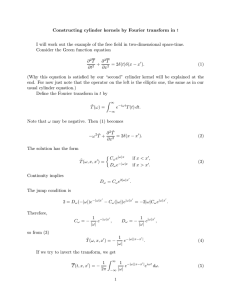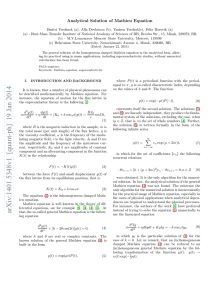ω ) , Q
advertisement
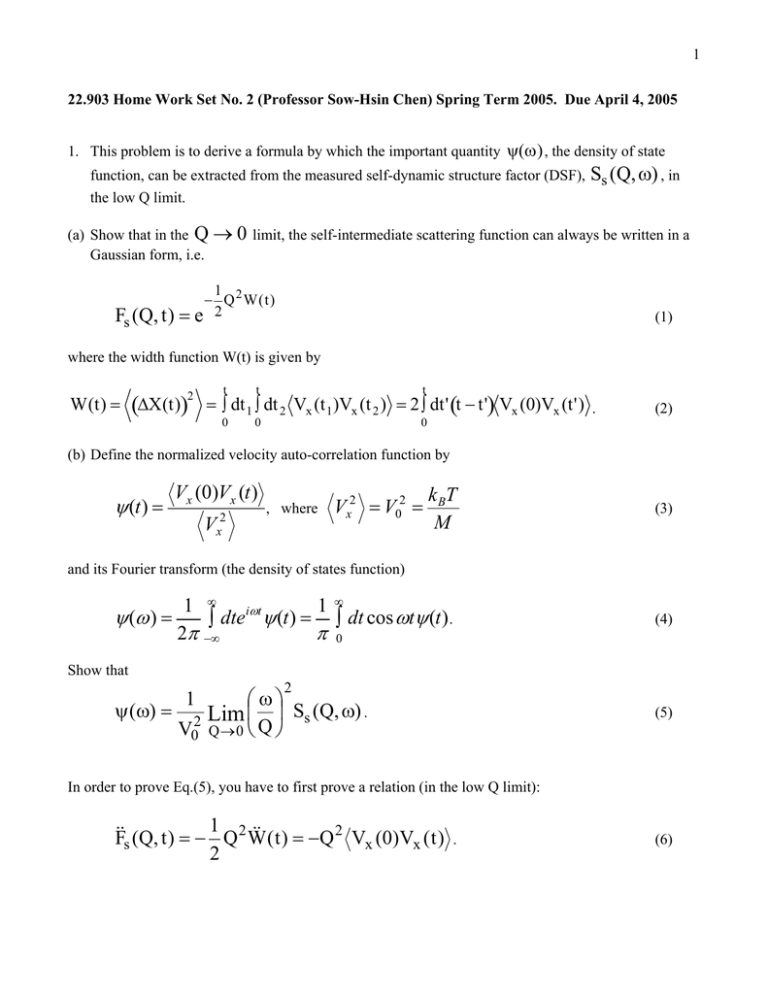
1 22.903 Home Work Set No. 2 (Professor Sow-Hsin Chen) Spring Term 2005. Due April 4, 2005 1. This problem is to derive a formula by which the important quantity ψ(ω) , the density of state function, can be extracted from the measured self-dynamic structure factor (DSF), Ss (Q, ω) , in the low Q limit. (a) Show that in the Q → 0 limit, the self-intermediate scattering function can always be written in a Gaussian form, i.e. Fs (Q, t ) 1 − Q2W(t) =e 2 (1) where the width function W(t) is given by t t t 0 0 0 W(t) = (∆X(t)) = ∫ dt 1 ∫ dt 2 Vx (t 1 )Vx (t 2 ) = 2 ∫ dt' (t − t') Vx (0)Vx (t') . 2 (2) (b) Define the normalized velocity auto-correlation function by Vx (0)Vx (t) k BT M (3) 1 ∞ iωt 1∞ ψ (ω ) = ∫ dte ψ (t ) = ∫ dt cos ωtψ (t ) . 2π −∞ π 0 (4) ψ (t) = Vx2 , where Vx2 = V02 = and its Fourier transform (the density of states function) Show that 2 ⎛ ω⎞ ψ (ω) = 2 Lim ⎜ ⎟ Ss (Q, ω) . V0 Q → 0 ⎝ Q ⎠ 1 (5) In order to prove Eq.(5), you have to first prove a relation (in the low Q limit): Fs (Q, t ) = − 1 Q 2 W ( t ) = −Q 2 Vx (0)Vx ( t ) 2 . (6) 2 2. This problem concerns calculation of the linear response function and its related susceptibility function of an one dimensional damped harmonic oscillator (DHO) subject to an applied external force h(t). The average displacement < x(t) > of the oscillator satisfies an equation of motion of a DHO given by Ý(t) > +Mγ < xÝ(t) > +Mω 20 < x(t) >= h(t) M < xÝ (7) Mγ and Mω02 are the friction constant and the spring constant respectively. The linear response function φ( t ) is defined by the following equation : where t x ( t ) = ∫ dt ' φ( t − t ' )h ( t ' ) (8) −∞ The response function can be obtained by taking an impulsive applied force h ( t ) = hδ ( t ) . (9) In this case from Eq.(8) and Eq.(9), we have x ( t ) = hφ( t ) . (10) From Eq.(10), Eq.(9) and Eq.(7), we obtain and equation for the response function as: Ý Ý(t) + MγφÝ(t) + Mω 20 φ(t) = δ(t) . Mφ (11) Remember the definition of the susceptibility function ∞ ∞ χ[ω] = − Lim ∫ dtφ( t ) exp(− iωt − εt ) = − ∫ dtφ( t )θ( t ) exp(− iωt − εt ) . (12) ε →0 0 −∞ where we introduce a unit step function, θ( t ) = 1 for t > 0, and θ(t) = 0 for t < 0 . (a) Show that the complex susceptibility function can be calculated by using Eq.(11) and Eq.(12) as: χ[ω] = 1 M (ω 2 − ω02 − iγω) and the dissipation function follows from it as (13) 3 Mχ' '[ω] = (ω γω 2 ) 2 − ω02 + (γω) , (14) 2 which is an odd function of the frequency and vanishes when the friction go to zero. (b) Show that the response function can be calculated from the susceptibility function as: ⎛ 1 ⎞ ⎛1 ⎞ 1 ∞ 2 φ(t) = − exp⎜ − γt ⎟ sin⎜ Ωt ⎟, t > 0 ∫ dω exp(iωt)χ[ω] = ⎝ 2 ⎠ ⎝2 ⎠ 2π −∞ MΩ (15) Ω 2 = 4ω02 − γ 2 . It is seen that for small damping, the response function oscillates in time with a frequency ω0 . But for sufficiently large damping, it does not oscillate. We call this latter where case an over-damped harmonic oscillator. Plot the response function for these two cases. (c) Finally let us define the displacement-displacement correlation function by: φ x (t) = x(0)x(t) . (16) Then with the help of the Wiener-Khintchin theorem, shown in the class notes, which states: S x (ω) = 1 ∞ ∫ dtφ x (t)e−iωt 2π −∞ (17) where the power spectral density function S x (ω) is defined by the equation: S x (ω)δ(ω − ω') = x(ω)x(ω') (18) show that φ x (t) = γ Ω ⎞ −γt / 2 kB T ⎛ Ω cos t + sin t ⎟e ⎜ . Ω 2 ⎠ 2 Mω 20 ⎝ Explain this result in the context of the fluctuation-dissipation theorem. (19) 4 (d) Prove the following relation that holds if x(t) is a stationary random process, d2 x (0) x ( t ) = − x (0) x ( t ) = − v(0) v( t ) dt 2 . Use the above theorem to calculate the velocity auto-correlation function (20) φv ( t ) of the DHO.
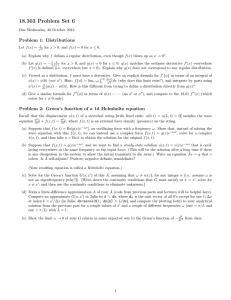
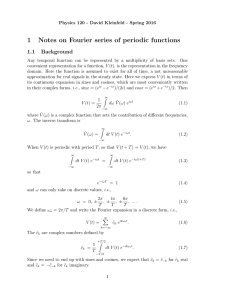
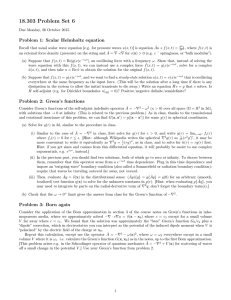

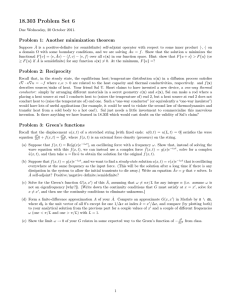
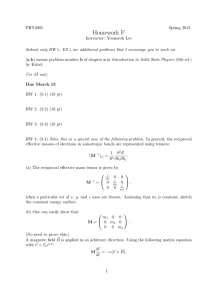
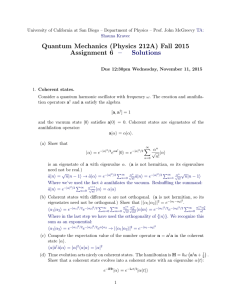
![PHYSICS 110A : CLASSICAL MECHANICS DISCUSSION #2 PROBLEMS [1] Solve the equation ...](http://s2.studylib.net/store/data/010997211_1-e584bd0bef85c1b26003f14bc9b84c94-300x300.png)
